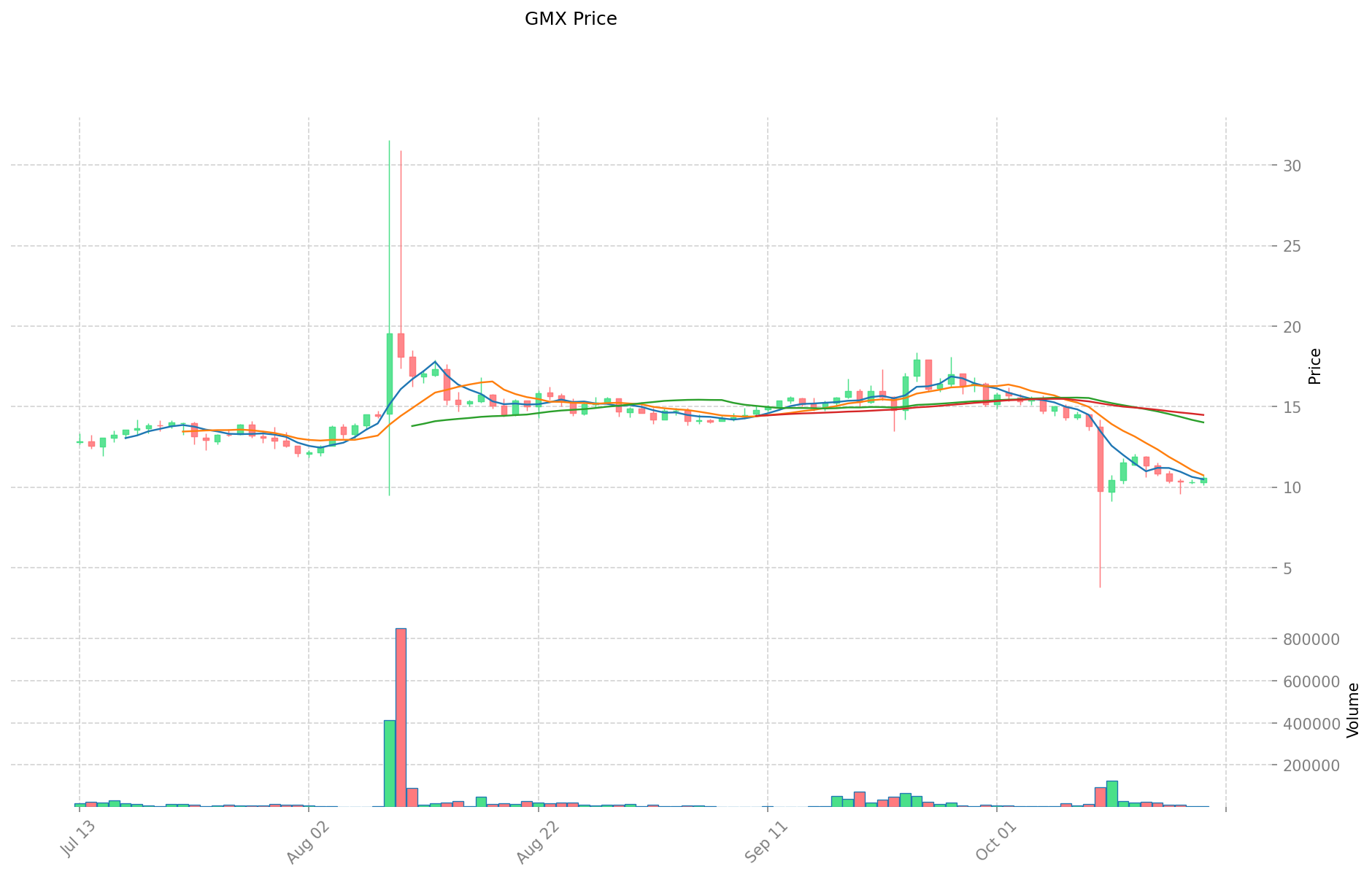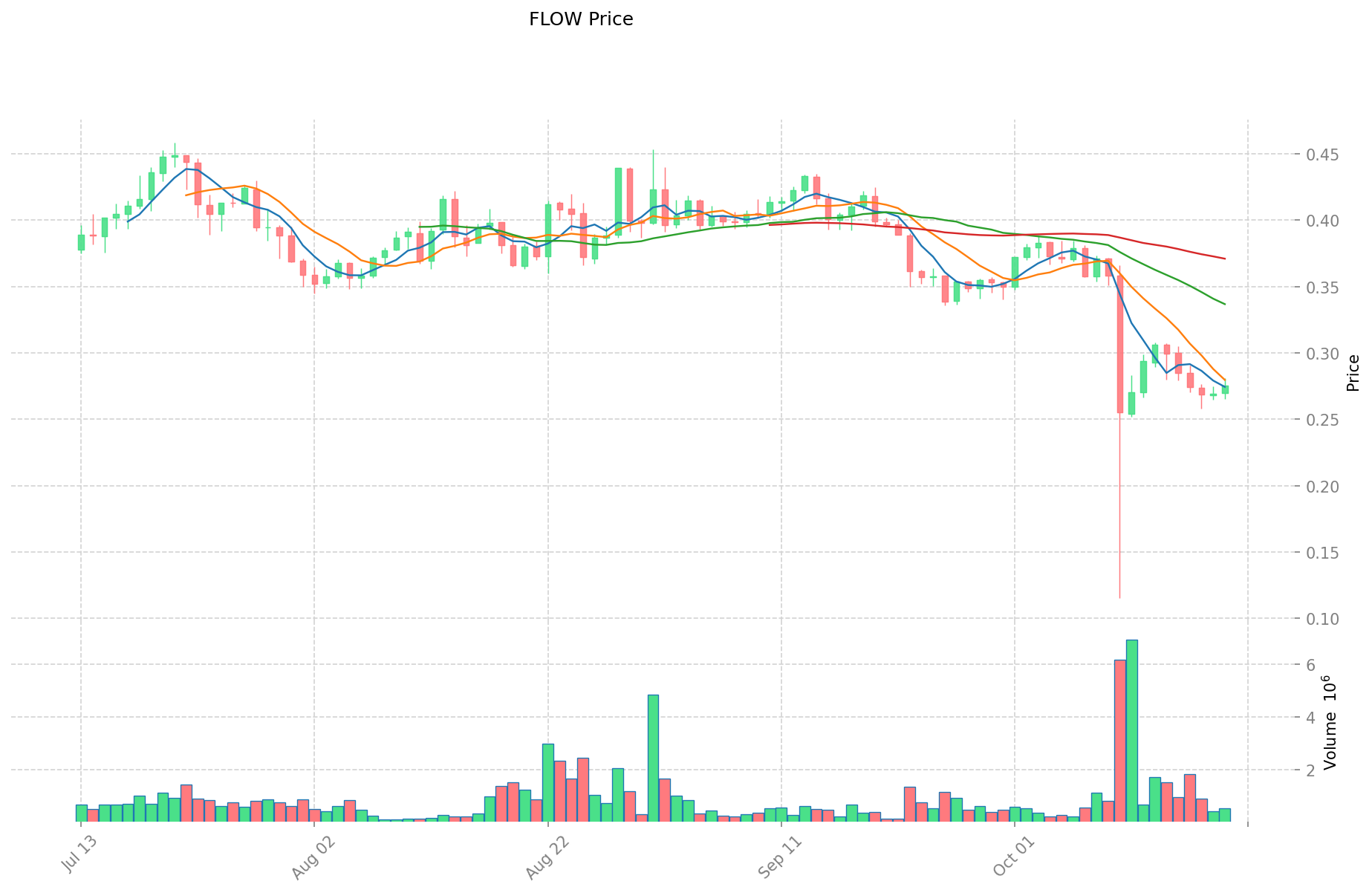GMX vs FLOW: Comparing Two Leading Blockchain Gaming Ecosystems
Introduction: GMX vs FLOW Investment Comparison
In the cryptocurrency market, the comparison between GMX vs FLOW has always been a topic that investors cannot ignore. The two not only have significant differences in market cap ranking, application scenarios, and price performance, but also represent different crypto asset positioning.
GMX (GMX): Since its launch, it has gained market recognition for its decentralized perpetual exchange platform.
Flow (FLOW): Since its inception in 2020, it has been hailed as a platform for next-generation games and applications, being one of the most popular blockchain networks for digital assets and decentralized applications.
This article will comprehensively analyze the investment value comparison between GMX vs FLOW, focusing on historical price trends, supply mechanisms, institutional adoption, technical ecosystems, and future predictions, attempting to answer the question that investors are most concerned about:
"Which is the better buy right now?"
I. Price History Comparison and Current Market Status
GMX (Coin A) and FLOW (Coin B) Historical Price Trends
- 2023: GMX reached its all-time high of $91.07 on April 18, 2023.
- 2021: FLOW reached its all-time high of $42.40 on April 5, 2021.
- Comparative analysis: Since their respective all-time highs, GMX has fallen from $91.07 to $10.48, while FLOW has dropped from $42.40 to $0.2754.
Current Market Situation (2025-10-20)
- GMX current price: $10.48
- FLOW current price: $0.2754
- 24-hour trading volume: GMX $38,498.12 vs FLOW $145,413.01
- Market Sentiment Index (Fear & Greed Index): 29 (Fear)
Click to view real-time prices:
- Check GMX current price Market Price
- Check FLOW current price Market Price


II. Key Factors Affecting Investment Value of GMX vs FLOW
Supply Mechanisms Comparison (Tokenomics)
-
GMX: Fixed maximum supply of 13.25 million tokens with potential for deflationary effects through token burning mechanisms
-
FLOW: Inflationary model with no maximum cap, designed for ecosystem growth and staking rewards
-
📌 Historical Pattern: Fixed supply models like GMX's tend to create upward price pressure during periods of increased demand, while FLOW's unlimited supply can dilute token value without sufficient network growth.
Institutional Adoption and Market Applications
- Institutional Holdings: GMX has attracted more trader-focused institutional interest due to its derivatives exchange utility, while FLOW has seen adoption from entertainment and gaming companies
- Enterprise Adoption: GMX is primarily used in DeFi trading infrastructure, while FLOW has gained traction in NFT marketplaces, gaming, and entertainment applications
- Regulatory Attitudes: Derivatives platforms like GMX face increasing regulatory scrutiny in many jurisdictions, while FLOW's focus on NFTs and gaming faces comparatively less regulatory pressure in most markets
Technical Development and Ecosystem Building
- GMX Technical Upgrades: Enhanced leverage trading capabilities, multi-chain expansion to Arbitrum and Avalanche, and improved risk management systems
- FLOW Technical Development: Transition to a more decentralized validator model, improved smart contract functionality, and enhanced developer tools
- Ecosystem Comparison: GMX has developed a robust DeFi trading ecosystem with focus on perpetual futures and options, while FLOW has built a diverse ecosystem around NFTs, gaming, and entertainment applications with partnerships like NBA Top Shot
Macroeconomic Factors and Market Cycles
- Performance in Inflationary Environment: GMX's fee-sharing mechanism provides passive income that may offset inflation, while FLOW lacks similar direct inflation-hedging properties
- Macroeconomic Monetary Policy: Rising interest rates have generally pressured both tokens, with GMX showing more resilience due to its utility in trading volatile markets
- Geopolitical Factors: Increased regulatory oversight of derivatives trading globally poses risks to GMX, while FLOW's entertainment focus provides some insulation from cross-border transaction restrictions
III. 2025-2030 Price Prediction: GMX vs FLOW
Short-term Prediction (2025)
- GMX: Conservative $5.92 - $10.38 | Optimistic $10.38 - $13.81
- FLOW: Conservative $0.25 - $0.27 | Optimistic $0.27 - $0.33
Mid-term Prediction (2027)
- GMX may enter a growth phase, with expected prices $7.61 - $16.24
- FLOW may enter a recovery phase, with expected prices $0.25 - $0.54
- Key drivers: Institutional capital inflow, ETFs, ecosystem development
Long-term Prediction (2030)
- GMX: Base scenario $14.55 - $18.42 | Optimistic scenario $18.42 - $22.47
- FLOW: Base scenario $0.42 - $0.61 | Optimistic scenario $0.61 - $0.82
Disclaimer: The above predictions are based on historical data and market trends. Cryptocurrency markets are highly volatile and unpredictable. This information should not be considered as financial advice. Always conduct your own research before making investment decisions.
GMX:
| 年份 | 预测最高价 | 预测平均价格 | 预测最低价 | 涨跌幅 |
|---|---|---|---|---|
| 2025 | 13.8054 | 10.38 | 5.9166 | 0 |
| 2026 | 17.171634 | 12.0927 | 11.729919 | 15 |
| 2027 | 16.24170537 | 14.632167 | 7.60872684 | 39 |
| 2028 | 17.5981072509 | 15.436936185 | 13.43013448095 | 47 |
| 2029 | 20.3165517130785 | 16.51752171795 | 11.3970899853855 | 57 |
| 2030 | 22.468784792927385 | 18.41703671551425 | 14.549459005256257 | 75 |
FLOW:
| 年份 | 预测最高价 | 预测平均价格 | 预测最低价 | 涨跌幅 |
|---|---|---|---|---|
| 2025 | 0.329483 | 0.2723 | 0.253239 | -1 |
| 2026 | 0.424257015 | 0.3008915 | 0.16248141 | 9 |
| 2027 | 0.540235643675 | 0.3625742575 | 0.2465504951 | 31 |
| 2028 | 0.600368584281375 | 0.4514049505875 | 0.27987106936425 | 63 |
| 2029 | 0.699429400687801 | 0.525886767434437 | 0.42070941394755 | 90 |
| 2030 | 0.8209618326419 | 0.612658084061119 | 0.422734078002172 | 122 |
IV. Investment Strategy Comparison: GMX vs FLOW
Long-term vs Short-term Investment Strategies
- GMX: Suitable for investors focused on DeFi trading and yield generation
- FLOW: Suitable for investors interested in NFT and gaming ecosystem potential
Risk Management and Asset Allocation
- Conservative investors: GMX: 30% vs FLOW: 70%
- Aggressive investors: GMX: 60% vs FLOW: 40%
- Hedging tools: Stablecoin allocation, options, cross-currency portfolio
V. Potential Risk Comparison
Market Risk
- GMX: Highly dependent on DeFi trading volume and market volatility
- FLOW: Vulnerable to shifts in NFT and gaming market trends
Technical Risk
- GMX: Scalability, network stability on Arbitrum and Avalanche
- FLOW: Decentralization challenges, potential smart contract vulnerabilities
Regulatory Risk
- Global regulatory policies may have a more significant impact on GMX due to its focus on derivatives trading, while FLOW faces relatively less regulatory pressure in most markets
VI. Conclusion: Which Is the Better Buy?
📌 Investment Value Summary:
- GMX advantages: Fixed supply, fee-sharing mechanism, established DeFi trading platform
- FLOW advantages: Strong partnerships in NFT and gaming sectors, potential for ecosystem growth
✅ Investment Advice:
- New investors: Consider a balanced approach, leaning towards FLOW for its more mainstream applications
- Experienced investors: Explore GMX for its DeFi yield potential, but maintain a diversified portfolio
- Institutional investors: Evaluate GMX for trading infrastructure exposure and FLOW for entertainment sector blockchain adoption
⚠️ Risk Warning: The cryptocurrency market is highly volatile. This article does not constitute investment advice. None
VII. FAQ
Q1: What are the key differences between GMX and FLOW? A: GMX is a decentralized perpetual exchange platform with a fixed supply, while FLOW is a blockchain network for digital assets and decentralized applications with an inflationary token model. GMX focuses on DeFi trading, while FLOW targets NFTs, gaming, and entertainment applications.
Q2: Which token has performed better historically? A: GMX reached its all-time high more recently (April 2023) at $91.07, while FLOW's all-time high was in April 2021 at $42.40. However, both have seen significant drops since their peaks, with GMX currently at $10.48 and FLOW at $0.2754.
Q3: How do their supply mechanisms differ? A: GMX has a fixed maximum supply of 13.25 million tokens with potential deflationary effects through token burning. FLOW has an inflationary model with no maximum cap, designed for ecosystem growth and staking rewards.
Q4: What are the main risks associated with investing in GMX and FLOW? A: GMX faces risks related to DeFi trading volume, market volatility, and potential regulatory scrutiny of derivatives trading. FLOW is vulnerable to shifts in NFT and gaming market trends, as well as challenges in decentralization and smart contract vulnerabilities.
Q5: Which token is predicted to have higher growth potential by 2030? A: Based on the provided predictions, GMX is expected to reach $14.55 - $22.47 by 2030 in optimistic scenarios, while FLOW is predicted to reach $0.42 - $0.82. However, these predictions are subject to market volatility and should not be considered financial advice.
Q6: How might institutional adoption affect these tokens? A: GMX has attracted more trader-focused institutional interest due to its derivatives exchange utility, while FLOW has seen adoption from entertainment and gaming companies. This difference in institutional focus could impact their future growth and market positioning.
Q7: What factors should investors consider when choosing between GMX and FLOW? A: Investors should consider their risk tolerance, investment horizon, and interest in specific blockchain applications. GMX may be more suitable for those interested in DeFi trading and yield generation, while FLOW might appeal to investors focused on NFTs and gaming ecosystems. It's also important to consider the regulatory environment and potential market risks associated with each token.
Share
Content